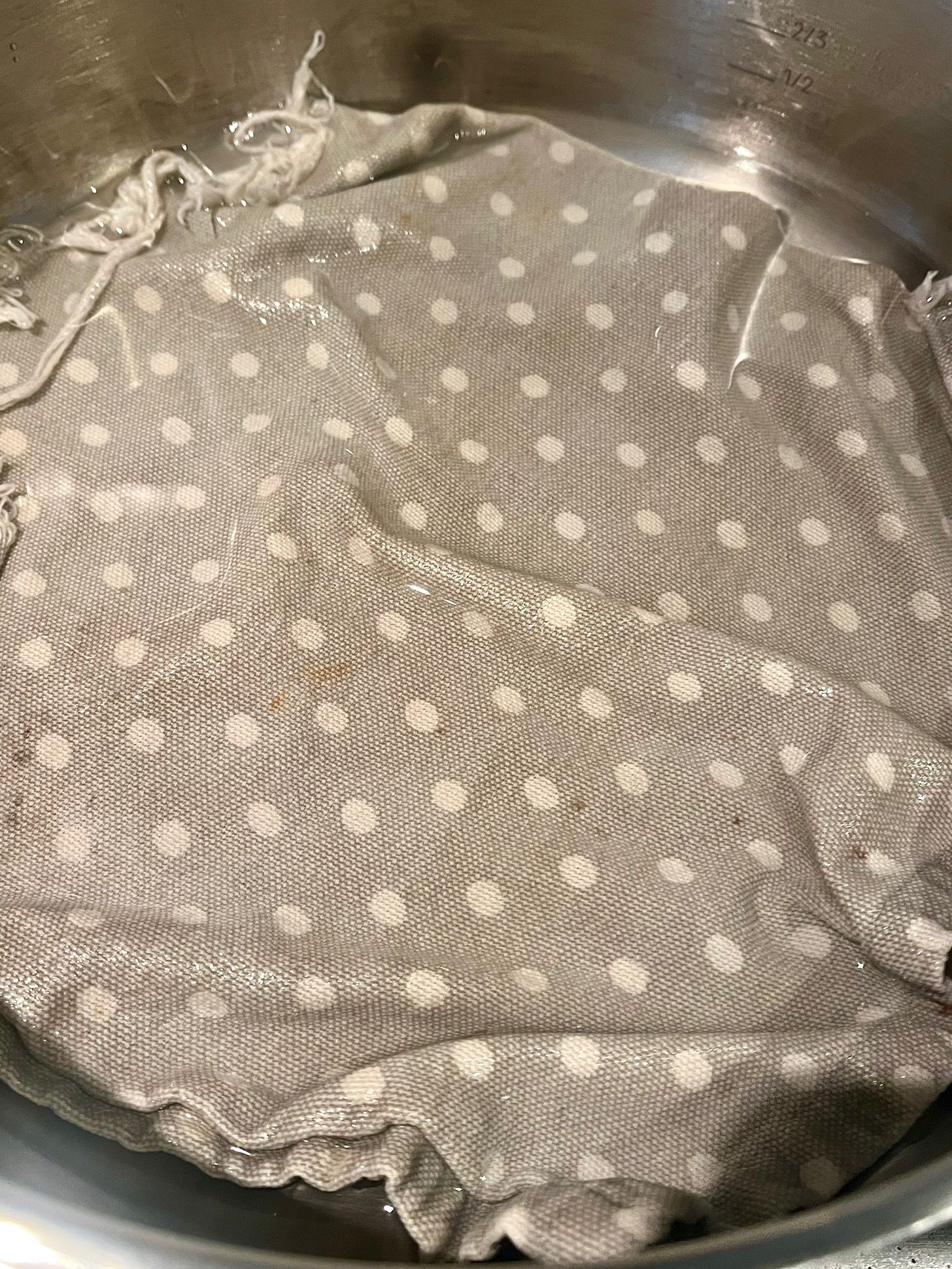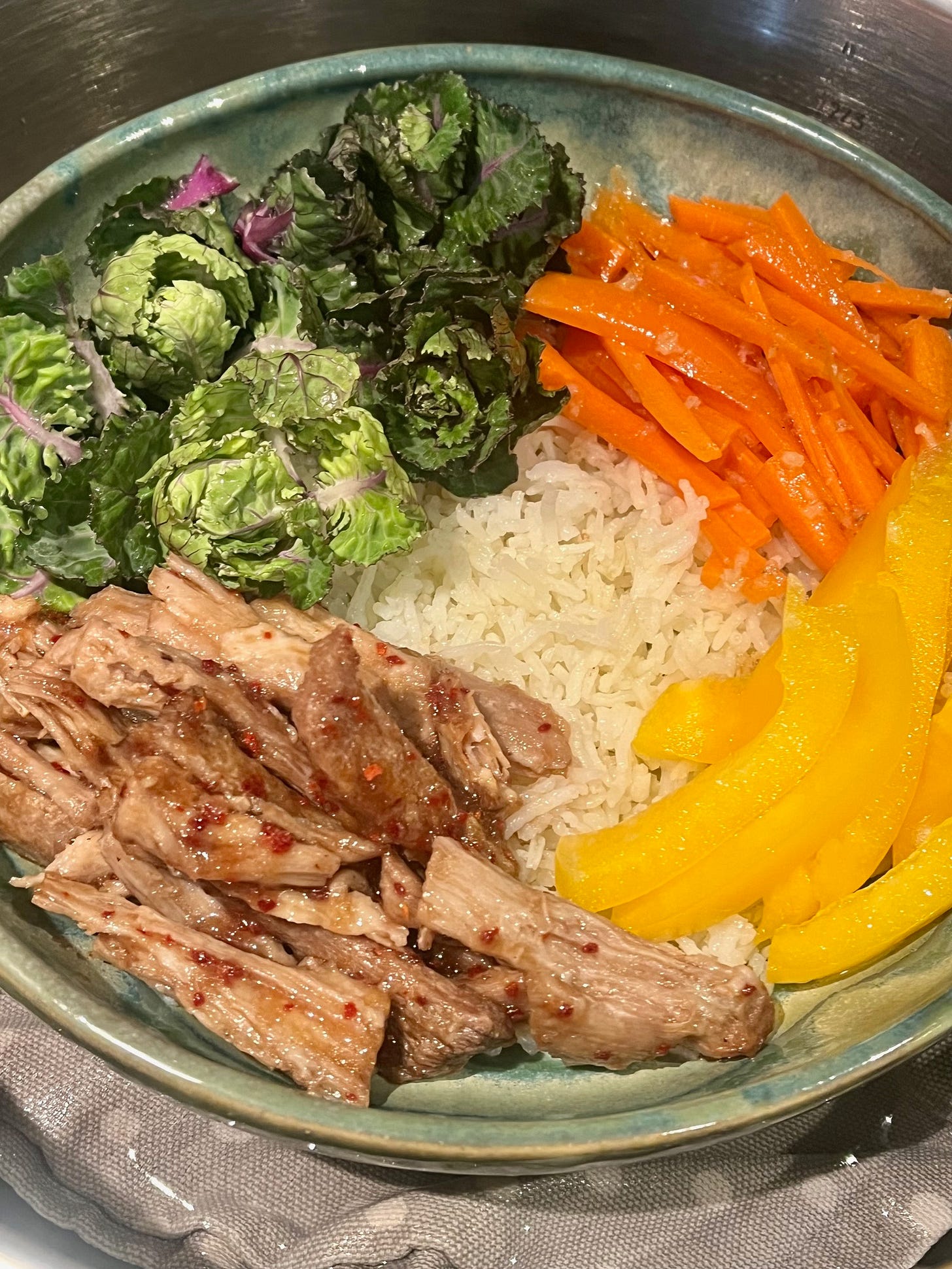First off, thank you to the few hundred of you who took part in my little questionnaire last week. I must admit, I was quite surprised by the results, I thought there would be more vegetarians and vegans among you:
83% omnivore
5% pescatarian
5% vegetarian
2% vegan
4% other
Not many people specified exactly what they meant by “other” but I think it often does mean that you are omnivore but trying to cut down on meat/dairy or that you have some other dietary restriction/allergy. Flexitarian?
Anyway, today’s recipe should suit most of you because it can be vegan/vegetarian/pescetarian/carnivorous as you like. Because there are OPTIONS.
This one’s for you, Lilly….
Since Adam has developed a bit of an obsession with pressure cooking basmati rice, there are always leftovers. I’m not complaining - I like the fact that he wants to perfect the food he cooks. He is very thorough in the rinsing and makes sure he does the little things that make such a difference - eg., covering with a tea towel and leaving to steam off the heat for a few minutes after the pressure has dropped. And I like having leftover rice to use too. His after school snack is frequently now an egg fried rice - he loves wok cooking, but everyone else uses it up too.
Cooked rice can clump together so what I normally do before storing is toss in a little oil - usually sesame oil, but use whatever you like - and break the rice up. So even if it regroups, it will still break apart very easily when you want to use it, regardless of whether it is chilled or frozen.
I think I’ve mentioned a few million times that often ideas for methods/recipes come out of being asked a question. This one came from Lilly - she came home from sixth form one lunchtime wanting to make bibimbap (a very good example of a Korean moveable feast) with some of the leftover rice. Could she reheat in the pressure cooker? And if so, could she reheat it in the bowl she wanted to use to build the bibimbap in, and so save on washing up?
Normally when I reheat rice I usually just do it in the base of the pressure cooker with a splash of water. I might do this on its own, I might put the rice on one side and whatever else I am reheating on the other so I can still serve separately or one on top of another. I could use dividers for this, but I never bother. I might mix them together - eg., a portion of keema peas and a portion of rice will reheat together happily and can be stirred together into a keema biryani type thing. If I am cooking something from scratch which takes more than zero minutes, I might reheat the rice alongside but wrapped in foil so a) it doesn’t overcook and b) doesn’t absorb too much liquid.
I couldn’t think of any good reason why rice shouldn’t be reheated in a bowl - in fact, I thought it would probably help prevent over cooking. So I told Lilly to put a piece of fabric in the base, cover with water and put the bowl on top. The fabric - usually a napkin or a torn piece of tea towel (see my very tatty, stained but clean piece below), acts as a barrier between bowl and base of the pressure cooker and stops the former from rattling around. You can simply use a trivet instead if you prefer. The rice will be better - drier - if the bowl is covered in greaseproof paper and sealed with string or a large rubber band. The rubber band is easier and something you are more likely to do for a quick solo lunch, I find. And you can reuse the same piece of parchment - just let it cool and dry out and fold it up with the rest of your pressure cooker accessories (assuming you are much neater/more organised than I am and keep together in the same place).
The rice will be piping hot if you bring the cooker up to low pressure and fast release. Unless it is in a solid block in which case you might need to bring it up to high pressure. But that is all it takes. So it worked for Lilly and she was happy and I should also mention here that it will also work with other types of rice/grains. You don’t have to be wedded to white basmati. I would normally cook a wholegrain rice of some sort, but letting Adam have his way at the moment.
Now, onto the bibimbap. Because of course I thought to take the bowl reheating a stage further and add other things. Bibimbap can contain all kinds of ingredients, cooked in different ways or left raw. I thought about what I could legitimately cook with the rice. The answer is any vegetables which will take zero minutes. And you can also use it to reheat meat. You can also cook thin strips of meat/fish/seafood in the time too - but the issue with this is that they will give out a fair bit of water when they are cooked which can flood the rice. Fine if you want a soupy dish (although you can strain the liquid off), but not if you want a fairly dry bibimbap. I would instead just sautee, drizzle in the same sauce and let it caramelise a bit.
So I messed around with this a bit today.
I had:
Some strips of roast pork, from the freezer which I defrosted and dressed (see below)
Kalettes (could have used any zero minute vegetables here)
Carrots, cut slightly thicker than a julienne, so they cooked to al dente
Yellow pepper.
These formed the base of the cooked elements:
Then I added in some raw elements and condiments.
Here’s the recipe, but just use whatever you like. I think a protein element is important - you can add the traditional fried egg which I didn’t do today as Shariq had made me a huge fried egg sandwich for breakfast. All the vegan options apply. I never cook tofu as I am allergic to it, but the extra firm stuff, marinaded and grilled, would be good here, as would the silken sort, chilled and dressed. Coriander would have been nice - I just added a few coriander stems from the freezer as it was all I had.
You can use this method for all kinds of things - anything that will go well with rice or other grains and takes minimal cooking. I am not going to limit it to Korean food at all. I will probably share some of my improvisations over the following weeks as Adam is still doing most of the cooking and I don’t expect we’ll be short of cooked rice leftovers any time soon….
A quick Bibimbap from leftovers
You can make this as simple or as complicated as you like. I wanted a variation in flavours, so dressed some of the elements separately. But you can just make one sauce and drizzle it over everything once cooked if you prefer.
For the cooked elements:
1 portion cooked rice
Some cooked meat
A few greens (I used a handful of kalettes)
1 carrot, cut into slim baton
A slither of ginger, finely grated
1/4 pepper, cut into strips
For the sauce:
1 tsp honey
1 tsp chilli paste or flakes
1 tbsp soy sauce
1 tsp mirin
1 tsp rice vinegar
1/2 tsp sesame oil
1 cloves garlic, grated
For the pickled vegetables:
1/2 shallot, finely sliced
3 radishes, sliced into rounds
A chunk of cucumber, cut into crescents
1 tbsp Japanese rice vinegar
1/4 tsp sugar
To finish (all optional):
A fried egg
Kimchi
Any sauces you like such as gochujang, mixed with a little soy, chilli oil, peanut rayu
Chilli flakes
Sesame oil
Soy sauce
sesame seeds
Shredded spring onions
Salad leaves
herbs
Method
First make the sauce by whisking everything together and making sure the honey has dissolved. Taste for heat/sweetness and seasoning - if you use dark soy sauce you will need more salt than if you use light. Drizzle half the sauce over the meat and toss to coat thoroughly.
Toss the carrot in the ginger and season.
Pickle the vegetables - mix the vinegar with the sugar and 1/2 tsp salt. Coat the vegetables in this pickling liquid and leave to stand for just the length of time it takes the rice to reheat.
Spread the rice over the base of your bowl and arrange the meat, carrot, greens and pepper over it. Cover the bowl with a piece of greaseproof paper and seal with string or a sturdy elastic band.
Put a piece of fabric or a trivet in the base of your pressure cooker and add around 1 cm water. Place the covered bowl on the fabric or trivet. Close the lid and bring up to high pressure. Immediately remove from the heat, leave to stand for 30 seconds and release the remaining pressure. Remove the greaseproof paper.
Carefully remove the bowl from the cooker. Drizzle with the remaining sauce. Add the pickled vegetables and anything else you like, including a fried egg and various condiments/oils/herbs. Make sure when you eat that you remember to protect yourself from the bowl which will still be hot!
Thank you for reading! And thank you for recent comments and questions, as quite a few of them have given me plenty to think about and subjects for future posts. Please share with anyone you think might appreciate it, and as always, please take a moment to click on the heart if you have enjoyed. Thank you again!







I didn’t see the questionnaire but I am vegetarian. I’m loving adapting your recipes - we had the bacon and onion suet roll the other day using a pack of chestnut stuffing - it was delicious!
I really like the sound of this! When I’m wfh I enjoy a little break for creativity and having something easy to assemble and then blast in the pressure cooker ticks that box. I can imagine having enough sauce to use for 3/4 days with different veg/protein to ring the changes too. Thank you!